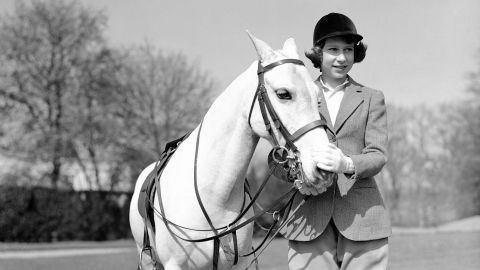CNN
—
Who can forget the Queen’s reaction at Royal Ascot in 2013 when her racehorse Estimate won the prestigious Gold Cup?
It was a rare moment when her public front slipped as the then 87-year-old – with all the enthusiasm of a young girl – watched from the Royal Box and pushed her mare to the winning line.
It was an extraordinary moment that will long be remembered by many observers, as it offered a human side that seldom shines amidst all the pomp and protocol.
The races were one of the few occasions when the Queen was able to appear in public for a few moments and mingle with the race-goers as a pure race fan. However, as athletes know, she was far from just being a fan.
Horses played a central role in the Queen’s life from an early age.
She was just 16 when she visited a racing stable for the first time. Her father, George VI, went with her to get his eye on two top class racehorses – Big Game and Sun Chariot.
“She watched them do some canters ahead of some big races that were just around the corner,” journalist and author Julian Muscat told CNN in 2018.
“After that she went and patted them on the head and loved the feel and the silkiness of their coats.
“The story goes that she didn’t wash her hands for the rest of the day.”
Her love of horses has remained unbroken, whether it be her successful breeding of local ponies, her charitable work for horses, or most importantly, her long and fruitful relationship with the thoroughbred racehorse.
And while Estimate is arguably the Queen’s biggest win as an owner, since her coronation in 1953 she has enjoyed widespread success with multiple winners to her name.
She was named British Flat Racing Champion Owner in 1954 and 1957 and – with victories at the St Leger Stakes, Epsom Oaks, 1,000 Guineas and 2,000 Guineas – the only one of the five British Classic races to elude was the Epsom Derby.
Of all the horses she successfully owned, most were homebred.
It’s a side of the sport that she was particularly interested in and is said to have found satisfaction in seeing this horse as a foal, growing it up and then going to the races.
She was a regular visitor to the Royal Stud at Sandringham, Norfolk, and after the horses had finished their races they remained in her retired care. Of course, her first public appearance after the 2020 Covid-19 lockdown was when she rode one of her ponies around the grounds of Windsor Castle.
The racing world quickly paid her respects following news of her death.
Top jockey Frankie Dettori said it was an “honor in his life” to ride for the Queen on many occasions.
“As a man, it was a greater honor to have known such a remarkable person,” he added in a statement Twitter.
“I will forever be grateful for the time, kindness and humor Her Majesty has so warmly bestowed upon me. Thank you ma’am.”

It’s a common sight for trainers and owners to brief jockeys before races, discussing tactics and options, and the Queen was no different.
Had she run a horse in her colors at Royal Ascot, there is no doubt she would have been down in the parade ring, talking to the trainer and jockey while watching the other runners in the race.
Her knowledge of racing was considered encyclopaedic and she was the unofficial figurehead of British racing.
Such was her importance to the sport that racing events in the UK were canceled as soon as her death was announced.
Many of the overseas horses that come to Royal Ascot from the United States, Hong Kong and Australia come not for the prize money that stands behind virtually every other race, but for the prestige, much of which was associated with the Queen.
She missed the festival for the first time since her coronation that year as she continued to have mobility issues.
“Sitting with the Queen is a memory I will never forget for the rest of my life,” American coach Wesley Ward told Royal Ascot in 2016.
“We had a wonderful chat about the horses and she was very keen to speak to me as my horses are kinda springing forward and I was lucky enough to win a pair that way. And she asked me all about my tactics and how I train them to do it.
“So I just kind of looked at them and said, ‘Well, if you go to the front, they’re going to have to catch you.’ And she said, “I tell my coaches that.” It was like talking to someone who’s at the races. You kind of have to pinch yourself and realize you’re talking to the Queen of England.”
Her interest in horse racing has been passed down through the generations and while it has never been stronger than during the Queen’s reign, hopes are high that Prince Charles and the Duchess of Cornwall, who have had Royal Ascot runners in recent years, will continue the Royal become tradition.
